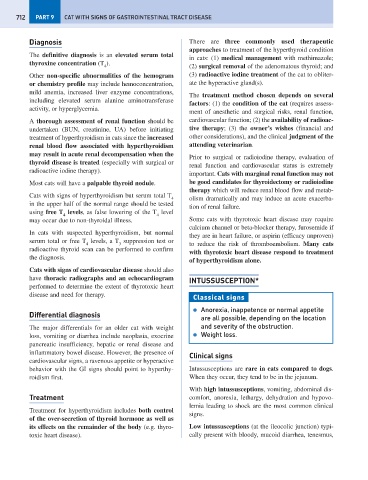Page 720 - Problem-Based Feline Medicine
P. 720
712 PART 9 CAT WITH SIGNS OF GASTROINTESTINAL TRACT DISEASE
Diagnosis There are three commonly used therapeutic
approaches to treatment of the hyperthyroid condition
The definitive diagnosis is an elevated serum total
in cats: (1) medical management with methimazole;
thyroxine concentration (T ).
4 (2) surgical removal of the adenomatous thyroid; and
Other non-specific abnormalities of the hemogram (3) radioactive iodine treatment of the cat to obliter-
or chemistry profile may include hemoconcentration, ate the hyperactive gland(s).
mild anemia, increased liver enzyme concentrations,
The treatment method chosen depends on several
including elevated serum alanine aminotransferase
factors: (1) the condition of the cat (requires assess-
activity, or hyperglycemia.
ment of anesthetic and surgical risks, renal function,
A thorough assessment of renal function should be cardiovascular function; (2) the availability of radioac-
undertaken (BUN, creatinine, UA) before initiating tive therapy; (3) the owner’s wishes (financial and
treatment of hyperthyroidism in cats since the increased other considerations), and the clinical judgment of the
renal blood flow associated with hyperthyroidism attending veterinarian.
may result in acute renal decompensation when the
Prior to surgical or radioiodine therapy, evaluation of
thyroid disease is treated (especially with surgical or
renal function and cardiovascular status is extremely
radioactive iodine therapy).
important. Cats with marginal renal function may not
Most cats will have a palpable thyroid nodule. be good candidates for thyroidectomy or radioiodine
therapy which will reduce renal blood flow and metab-
Cats with signs of hyperthyroidism but serum total T
4 olism dramatically and may induce an acute exacerba-
in the upper half of the normal range should be tested
tion of renal failure.
using free T levels, as false lowering of the T level
4 4
may occur due to non-thyroidal illness. Some cats with thyrotoxic heart disease may require
calcium channel or beta-blocker therapy, furosemide if
In cats with suspected hyperthyroidism, but normal
they are in heart failure, or aspirin (efficacy unproven)
serum total or free T levels, a T suppression test or
4 3 to reduce the risk of thromboembolism. Many cats
radioactive thyroid scan can be performed to confirm
with thyrotoxic heart disease respond to treatment
the diagnosis.
of hyperthyroidism alone.
Cats with signs of cardiovascular disease should also
have thoracic radiographs and an echocardiogram INTUSSUSCEPTION*
performed to determine the extent of thyrotoxic heart
disease and need for therapy.
Classical signs
● Anorexia, inappetence or normal appetite
Differential diagnosis
are all possible, depending on the location
The major differentials for an older cat with weight and severity of the obstruction.
loss, vomiting or diarrhea include neoplasia, exocrine ● Weight loss.
pancreatic insufficiency, hepatic or renal disease and
inflammatory bowel disease. However, the presence of Clinical signs
cardiovascular signs, a ravenous appetite or hyperactive
behavior with the GI signs should point to hyperthy- Intussusceptions are rare in cats compared to dogs.
roidism first. When they occur, they tend to be in the jejunum.
With high intussusceptions, vomiting, abdominal dis-
Treatment comfort, anorexia, lethargy, dehydration and hypovo-
lemia leading to shock are the most common clinical
Treatment for hyperthyroidism includes both control
signs.
of the over-secretion of thyroid hormone as well as
its effects on the remainder of the body (e.g. thyro- Low intussusceptions (at the ileocolic junction) typi-
toxic heart disease). cally present with bloody, mucoid diarrhea, tenesmus,

